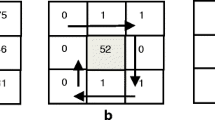Abstract
Faces extracted in bad light are affected in terms of unequal contrast, noise, and variant illumination. These kinds of disruptions decrease the accuracy of facial authentication real and complex environments. In this paper, a feature fusion method is provided to achieve illumination-robust face recognition. In this model, the Gaussian filter and Gabor filters are applied on facial image to generate the illumination-variant features. Each of the Gaussian and Gabor face is processed by LBP filter to generate the effective visual description for face. A block-level feature fusion is applied on Gaussian-LBP and Gabor-LBP faces to generate the composite feature pattern. This most relevant and adaptive feature patterns are processed on SVM classifier to recognize the face accurately. The proposed feature fusion model is applied on illumination, noise, and contrast-variant sample sets of extended Yale databases. The comparative results against SVM, KNN, and ANN methods verified the significant gain in accuracy of facial identification in complex environmental conditions.
Access this chapter
Tax calculation will be finalised at checkout
Purchases are for personal use only
Similar content being viewed by others
References
Juneja K (2017) A noise robust VDD composed PCA-LDA model for face recognition. In: International conference on information, communication and computing technology, pp 216–229
Juneja K (2016) MFAST processing model for occlusion and illumination invariant facial recognition. In: Advanced computing and communication technologies, pp 161–170
Huang S-M, Yang J-F (2012) Improved principal component regression for face recognition under illumination variations. IEEE Sig Process Lett 19(4):179–182
Juneja K (2017) Ring segmented and block analysis based multi-feature evaluation model for contrast balancing. In: International conference on information, communication and computing technology, pp 181–193
Juneja K (2017) Multiple feature descriptors based model for individual identification in group photos. J King Saud Univ Comput Inf Sci
Juneja K, Gill NS (2015) A hybrid mathematical model for face localization over multi-person images and videos. In: 2015 4th international conference on reliability, Infocom technologies and optimization (ICRITO) (trends and future directions), pp 1–6
Smeets DP (2012) A comparative study of 3-D face recognition under expression variations. IEEE Trans Syst Man Cybern Part C (Appl Rev) 42(5):710–727
Gopalan RS (2012) A blur-robust descriptor with applications to face recognition. IEEE Trans Pattern Anal Mach Intell 34(6):1220–1226
Mohammadzade H, Hatzinakos D (2013) Iterative closest normal point for 3D face recognition. IEEE Trans Pattern Anal Mach Intell 35(2):381–397
Ding LX (2012) Continuous pose normalization for pose-robust face recognition. IEEE Sig Process Lett 19(11):721–724
Liao SA (2013) Partial face recognition: alignment-free approach. IEEE Trans Pattern Anal Mach Intell 35(5):1193–1205
Lee P-H, Hsu G-S, Wang Y-W, Hung Y-P (2012) Subject-specific and pose-oriented facial features for face recognition across poses. IEEE Trans Syst Man Cybern Part B (Cybern) 42(5):1357–1368
Klare BF (2012) Face recognition performance: role of demographic information. IEEE Trans Inf Forensics Secur 7(6):1789–1801
Zafeiriou SG (2013) Face recognition and verification using photometric stereo: the photoface database and a comprehensive evaluation. IEEE Trans Inf Forensics Secur 8(1):121–135
Wang WW (2012) Recognition of blurred faces using local phase pattern. Electron Lett 48(20):1269–1271
Bonnen K, Klare BF, Jain AK (2013) Component-based representation in automated face recognition. IEEE Trans Inf Forensics Secur 8(1):239–253
Ho HT (2013) Pose-invariant face recognition using Markov random fields. IEEE Trans Image Process 22(4):1573–1584
Patel VM (2012) Dictionary-based face recognition under variable lighting and pose. IEEE Trans Inf Forensics Secur 7(3):954–965
De Marsico MM (2013) Robust face recognition for uncontrolled pose and illumination changes. IEEE Trans Syst Man Cybern Syst 43(1):149–163
Berretti SA (2013) Sparse matching of salient facial curves for recognition of 3-D faces with missing parts. IEEE Trans Inf Forensics Secur 8(2):374–389
Lee K-CJ (2005) Acquiring linear subspaces for face recognition under variable lighting. IEEE Trans Pattern Anal Mach Intell 27(5):684–698
Author information
Authors and Affiliations
Corresponding author
Editor information
Editors and Affiliations
Rights and permissions
Copyright information
© 2019 Springer Nature Singapore Pte Ltd.
About this paper
Cite this paper
Juneja, K., Rana, C. (2019). A Feature Fusion Method for Effective Face Recognition Under Variant Illumination and Noisy Conditions. In: Mishra, S., Sood, Y., Tomar, A. (eds) Applications of Computing, Automation and Wireless Systems in Electrical Engineering. Lecture Notes in Electrical Engineering, vol 553. Springer, Singapore. https://doi.org/10.1007/978-981-13-6772-4_82
Download citation
DOI: https://doi.org/10.1007/978-981-13-6772-4_82
Published:
Publisher Name: Springer, Singapore
Print ISBN: 978-981-13-6771-7
Online ISBN: 978-981-13-6772-4
eBook Packages: EngineeringEngineering (R0)




